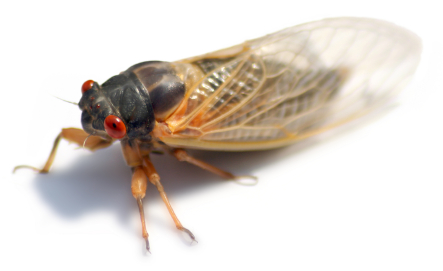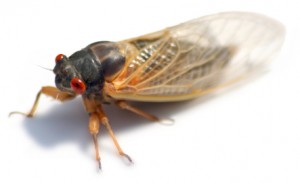 [1]After 13 years of inactivity, a Southern brood of cicadas, specifically known as the XIX Magicicada, are about to emerge after laying dormant underground. Although the cicadas are harmless to humans, they are however, a nuisance where gardens and trees are concerned. Cicadas, not to be confused with locusts, feed by attaching a nodule onto a branch and suck the nutrients from the tree.
[1]After 13 years of inactivity, a Southern brood of cicadas, specifically known as the XIX Magicicada, are about to emerge after laying dormant underground. Although the cicadas are harmless to humans, they are however, a nuisance where gardens and trees are concerned. Cicadas, not to be confused with locusts, feed by attaching a nodule onto a branch and suck the nutrients from the tree.
In an article by the British newspaper, Daily Mail [2], scientists indicate that “at this very moment, billions of the winged insect are crawling from their exoskeleton cages, ready to suck the sap out of every plant, tree and bush that gets in their way.”
Cicadas spend most of their life cycle underground feeding on root juice. During their final underground stage, they dig a tunnel to climb out and shed their skin on a plant. Cicadas then set about to mate. After mating, females cut slits in the bark of trees where they leave their eggs. When the eggs hatch the newborn nymphs fall to the ground and then burrow underground where the life cycle begins again.
Which Plants Are Most At Risk?
Because of the large brood that are ready to take flight, younger plants and trees (4 years of younger) can buckle under the strain of housing too many larvae. Cicadas will suck juices from baby fruit trees, garden vegetables, berry bushes and flowers. Specifically, more than 270 species of plants could be hosts for egg laying.
Some of the more vulnerable trees include: Maple, oak, hickory, beech, ash, dogwood, hawthorn, magnolia, willow, apple, peach, cherry and pear.
Flowers, vines and shrubs include: Rose of Sharon, rose, raspberry, grape, black-eyed Susan, hollies, spirea, rhododendron, viburnum, junipers, and arborvitae.
Source [3]
Protect Your Plants From Cicadas
The most efficient way to protect your plants is to encourage the cicadas natural predators. Predators such as birds, cicada killer wasps and the preying mantis are the cicadas natural born enemies. If the preying mantis is not already in your yard, ordering the larvae online and releasing them into the garden area can help control the cicadas around your home. Also providing bird houses and bird feeders to encourage birds to stay around could also assist in controlling any cicada populations around your home.
Another method being developed is spraying pheromones into the air to stress the insects. Director of International Centre of Insect Physiology and Ecology, Christian Borgemeister, has developed this method for controlling locust populations in Africa. In theory, this method could also work at controlling cicada populations.
He states that spraying the pheromone phenylacetonitrile (PAN), destroys the bands of insects. “The insects are highly stressed. They suffer high natural mortality and fall victim to the many natural enemies like birds.”
Using this method is also environmentally friendly and will not kill any of the beneficial insects in the area compared to spraying insecticides.
Get Ready For a Long Summer
Cicadas are relentless and will destroy vulnerable plants, trees and shrubs if given a chance. Keep an eye out for any infestations and try to control the cicadas in your area before they get out of hand. Educating yourself on natural ways to deter this nuisance can create a better living environment for the beneficial insects you want around.
